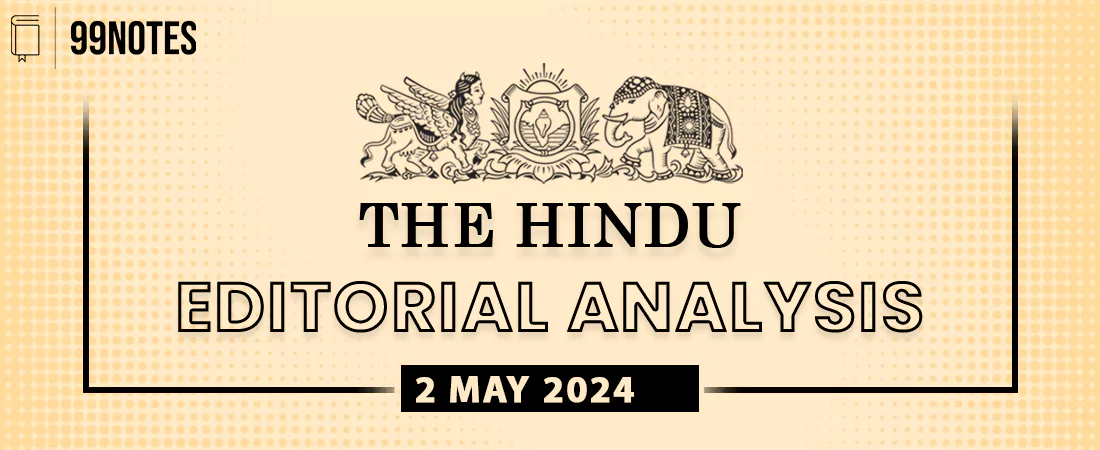2 May 2024 : The Hindu Editorial Notes PDF
1. The wrong way to fight inequality
| Topic: GS2 – Social Justice – Development and management of social sector/services.
Understanding income and wealth inequality in India is crucial for UPSC aspirants to grasp socioeconomic challenges and policy implications. |
| Context: |
| ● The article discusses research by economists, including Thomas Piketty, on income and wealth inequality in India, highlighting trends since the 1980s and proposing alternatives to wealth redistribution, emphasising economic freedom and competition. |
Introduction:
- Income and wealth inequality in India, as revealed by economists including Thomas Piketty, underscores profound socio-economic challenges.
- Trends since the 1980s reflect disparities in economic growth and access to opportunity, prompting debates on policy interventions to promote equity and inclusive development.
Overview of Income and Wealth Inequality in India:
- Economists, including Thomas Piketty, reveal alarming trends in income and wealth inequality in India over the past century.
- In 2022, the top 1% owned 40.1% of total wealth and earned 22.6% of total income, while the bottom 50% owned only 6.4% of wealth and earned 15% of income.
- Such disparity prompts calls for a wealth tax on the rich to address regressive tax policies.
Economic Growth and Inequality Trends:
- Inequality surged since the 1980s with the adoption of market policies, contrasting with stagnant growth during socialist decades.
- Despite the bottom 50% losing share of national income (from 23.6% to 15% since 1982), their real income increased over four-fold between 1991 and 2022.
- However, income gaps persist, with the top 1% earning significantly more than the bottom 50%.
Barriers to Economic Mobility
- Economic freedom isn’t equally distributed; the poor face barriers such as limited access to capital and high education costs.
- In a truly free market, such disparities would incentivize individuals to pursue higher-paying jobs, but barriers impede this progression.
- Liberalising sectors like finance and education could facilitate upward mobility by enabling investment in high-paying skills.
Inevitability of Wealth Inequality
- Wealth inequality is intrinsic to market economies, rewarding better investors and entrepreneurs.
- However, India’s extreme wealth gap is exacerbated by government favouritism toward the top 1%, hindering competition and exacerbating disparities.
- Addressing special privileges and fostering competition would naturally reduce wealth concentration.
Impact of Wealth Tax
- Introducing a wealth tax could have unintended consequences, as investors may reduce capital investments to maintain post-tax income.
- This indirectly affects workers and landowners, potentially lowering their income and output.
- Additionally, most of the top 1%’s wealth is in capital assets, not consumer goods, so taxing them wouldn’t directly address low living standards.
Alternative Solutions to Inequality
- Taxing the rich could impede economic growth and harm living standards.
- Instead, offering greater economic freedom to the poor would enable them to compete better in the market and claim a larger share of the economic pie.
Conclusion
- While the data on income and wealth inequality in India is alarming, solutions like a wealth tax may not address underlying issues effectively.
- Addressing barriers to economic mobility and fostering competition could offer more sustainable solutions to reduce inequality and improve living standards for all.
| Inequality in India |
| Inequality Trends in India:
● Wealth Inequality: Top 10% own 77% of national wealth; poorest half have only 4.1%. ● Income Inequality: Top 10% and 1% hold 57% and 22% of total income respectively; bottom 50% share reduced to 13%. ● Tax Burden: 64% of GST from bottom 50%; only 4% from top 10%. ● Global Hunger Index: India’s score at 28.7, considered serious; highest child-wasting rate. ● Healthcare Accessibility: 63 million pushed into poverty annually due to healthcare costs; majority unable to access needed care. (Source – The Economic Times, December 7, 2022) Causes of Increasing Inequality in India: ● Unequal Access to Education: Disparities in educational opportunities perpetuate socio-economic inequalities, limiting upward mobility for marginalised communities. ● Informal Sector Dominance: The dominance of the informal sector in India’s economy leads to low wages, insecure employment, and lack of social protection, exacerbating income disparities. ● Unequal Distribution of Wealth: Concentration of wealth among small elite contributes to widening income gaps and socio-economic inequalities. ● Caste and Gender Discrimination: Persistent caste-based and gender-based discrimination marginalise certain groups, limiting their access to opportunities and resources. ● Urban-Rural Divide: Disparities between urban and rural areas in terms of infrastructure, employment opportunities, and access to basic services widen income and wealth gaps. Way Forward: ● Investment in Education: Enhance access to quality education and skill development programs to promote equal opportunities for all. ● Job Creation: Implement policies to stimulate job creation, particularly in sectors with high labour-absorptive capacity, to reduce unemployment and underemployment. ● Social Protection: Strengthen social safety nets and welfare programs to provide financial support and assistance to vulnerable populations. ● Progressive Taxation: Introduce progressive tax policies to redistribute wealth and reduce income inequalities. ● Gender and Caste Equality: Promote gender equality and social inclusion through affirmative action policies and measures to address caste-based discrimination. ● Rural Development: Focus on rural development initiatives to bridge the urban-rural divide and promote inclusive growth. |
| PYQ: COVID-19 pandemic accelerated class inequalities and poverty in India. Comment. (150 words/10m) (UPSC CSE (M) GS-1 2020) |
| Practice Question: Discuss the implications of rising income and wealth inequality in India, as highlighted by economists like Thomas Piketty, and evaluate policy measures to address this issue. (150 Words /10 marks) |
2. India must collaborate with Indian Ocean countries for data on warming
| Topic: GS1 – Geography – Climate Change – Changes in water-bodies
GS3 – Environment – Environmental pollution and degradation Understanding Indian Ocean warming is crucial for UPSC aspirants to grasp climate change impacts on marine ecosystems and mainland India. |
| Context: |
| ● The article highlights projections of significant warming in the Indian Ocean, leading to increased marine heatwaves, coral bleaching, severe cyclones, and erratic monsoons in mainland India. |
Introduction:
- The projected warming of the Indian Ocean poses significant challenges for marine ecosystems and mainland India’s climate stability.
- With forecasts indicating increased marine heatwaves, coral bleaching, severe cyclones, and erratic monsoons, understanding and addressing these impacts are paramount for sustainable development and environmental protection.
Overview of Indian Ocean Warming
- The Indian Ocean has warmed by 1.2°C and is projected to heat up by 1.7°C to 3.8°C from 2020 to 2100.
- A recent study forecasts a tenfold increase in marine heatwaves, from 20 days per year to 220-250 days, leading to a near-permanent heatwave state.
- This warming trend extends beyond the surface, increasing the ocean’s heat content significantly.
Impact on Marine Ecosystems
- The rise in marine heatwaves threatens coral reefs, accelerating coral bleaching and damaging the fisheries sector.
- Accelerated warming, measured up to 2,000 meters below the surface, indicates a substantial increase in the ocean’s heat content.
- The thermal capacity of the Indian Ocean is rising at a rate of 4.5 zetta-joules per decade, expected to escalate to 16-22 zetta-joules per decade in the future.
Consequences for Mainland India
- Warming trends in the Indian Ocean contribute to more severe cyclones and erratic monsoon patterns in mainland India.
- The frequency of severe cyclones is expected to rise, alongside an increase in the intensity of monsoon rainfall, leading to prolonged droughts and floods.
Anthropogenic Contributions and Global Commitments
- Anthropogenic activities, particularly fossil fuel burning, significantly contribute to global warming and the resultant impacts on the Indian Ocean.
- Current global commitments to reduce greenhouse gas emissions may not adequately address the ocean’s warming, as marine systems respond slowly to external changes.
Need for Collaborative Action
- India must collaborate with Indian Ocean-bordering countries to enhance data gathering and projections to better understand local impacts.
- Investments in infrastructure development and protection should align with projections to mitigate risks associated with ocean warming.
Conclusion
- The warming of the Indian Ocean poses significant threats to marine ecosystems and mainland India’s climate stability.
- Urgent collaborative efforts are required to enhance data collection, projection accuracy, and infrastructure development to address the challenges posed by ocean warming effectively.
| Potential impact of warming of Indian ocean on Indian climate/weather |
| ● Increased Indian Ocean temperature may intensify monsoon rains, leading to more extreme precipitation events.
● Higher ocean heat content can fuel the formation and intensification of cyclones in the Arabian Sea and Bay of Bengal. ● Marine heatwaves could disrupt marine ecosystems, affecting fish stocks and coastal livelihoods. ● Coral bleaching due to sustained high temperatures may harm biodiversity and coastal protection. ● Thermal expansion of seawater contributes to sea-level rise, threatening coastal areas with inundation and erosion. ● Overall, these changes may have far-reaching consequences on agriculture, water resources, and coastal infrastructure in India. |
| PYQ: The Intergovernmental Panel on Climate Change (IPCC) has predicted a global sea level rise of about one metre by AD 2100. What would be its impact in India and the other countries in the Indian Ocean region? (250 words/15m)(UPSC CSE (M) GS-3 2023) |
| Practice Question: Discuss the potential impacts of Indian Ocean warming on marine ecosystems and mainland India’s climate stability, and suggest measures to mitigate these effects. (250 Words /15 marks) |




